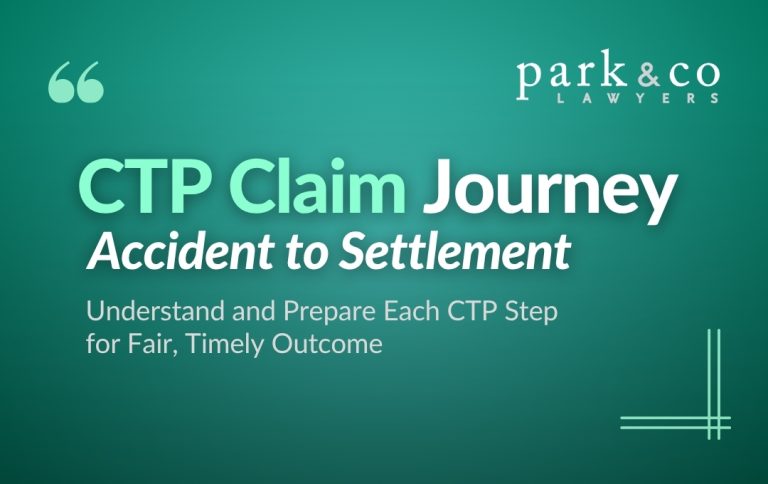Traffic accidents happen unexpectedly, and injuries can make the situation even more overwhelming. This guide walks you through the entire CTP claim process in Australia—from the moment the accident happens all the way to final settlement.
Step 1: The Critical “Golden Time” Right After the Accident
Your first priority at the scene is safety and evidence collection. Even in a stressful moment, try to remember the essentials:
Immediate actions
- Move to a safe area and call an ambulance if anyone is injured.
- Report the accident to police—even for minor crashes. A police report becomes key evidence during your claim.
- Take photos of the scene: vehicle damage, number plates, road conditions, and any relevant surroundings.
- Exchange details with the other driver, including name, contact information, vehicle registration and insurer.
Why medical records matter
If you feel any pain—even mild—see a GP or visit a hospital as soon as possible. Early medical treatment helps recovery and provides crucial evidence linking your injuries to the accident. Keep all medical documents: diagnoses, treatment notes, referrals, prescriptions, and receipts.
Step 2: Lodging Your CTP Claim
Submit your CTP claim with the insurer of the at-fault vehicle as soon as you can. You can usually identify the insurer by checking the rego details.
(Note: In VIC, NT, WA and TAS, CTP is managed by a government authority, so private insurer identification isn’t required.)
Information you’ll need
- Police event number
- Date, time, and location of the accident
- Details of the vehicles involved
- Witness contact information (if any)
- Medical certificates and treatment records
Once your claim is lodged, the insurer will issue a claim number and assign a case manager. Keep this number safe—it will be used throughout the entire process.
Step 3: Investigation & Injury Assessment
After your claim is submitted, the insurer will conduct an investigation to determine liability.
How insurers investigate
They may review:
- Police reports
- Witness statements
- Vehicle damage
- Accident scene evidence
- Medical records
If you are found partly responsible, your compensation may be reduced due to contributory negligence.
Medical assessments
Around 10–12 months after the accident, you may be asked to attend an assessment with an Independent Medical Examiner. Their report plays an important role in understanding the extent to which the injuries have impacted your life.
Be honest, clear, and specific:
- Don’t exaggerate or downplay symptoms
- Explain how your injuries affect daily life and work
- Mention ongoing pain, mobility issues, or lifestyle changes
Step 4: Understanding What You Can Claim
CTP insurance covers personal injury, not property damage. Knowing what compensation you’re entitled to helps during negotiation.
Common compensation categories
- Medical expenses: GP visits, specialist care, medication, rehab, physio
- Loss of earnings: time off work and potential future income loss
- Pain and suffering: assessed based on severity and ongoing impact
- Care and assistance: domestic help, transport costs, and support services (where applicable)
Step 5: Negotiating a Settlement
Once evidence is gathered—medical reports, expenses, and supporting documents—negotiation with the insurer begins.
Tips for effective negotiation
- Request a clear breakdown of how the insurer calculated their offer.
- Use medical opinions to support your claim.
- Keep all communication documented.
- Avoid responding emotionally—stick to facts and evidence.
Because the process can be legally and medically technical, many people choose to work with a personal injury lawyer. Most operate on a No Win, No Fee basis, meaning you don’t pay legal fees unless your case succeeds.
Step 6: Final Settlement
When both sides reach an agreement, you will sign a Deed of Release. This is a legally binding document confirming that you accept the settlement and will not pursue further claims for the same accident.
Before signing, check:
- Are all compensation categories correctly included?
- Does the amount cover future treatment needs or potential complications?
- Has a lawyer reviewed it? (Highly recommended)
Receiving your payment
Most settlements are paid within 4–8 weeks of signing. If you used a lawyer, legal fees will be deducted. Medicare and Centrelink may also require reimbursements depending on benefits received.
Final Thoughts
The CTP process can be stressful, but understanding each step helps you navigate it confidently. Your initial actions—collecting evidence and obtaining medical care—set the foundation for a successful claim.
And remember: you don’t need to handle the entire process on your own. If you’re feeling overwhelmed, speaking with an experienced personal injury lawyer can protect your rights and ensure you receive the compensation you’re entitled to.

Contact Us Today
We are experienced in the different areas of personal injury claims. We work on a no-win-no-fee basis which means that if you don’t win, you don’t have to pay our legal fees. Contact us today for a free, no-obligation initial consultation. We will discuss your case and make sure you know about your legal rights.







